Using coffee grounds in the garden is an appealing idea, and a quick Google search will bring up many hits. I’m not the only one who wants to hear that a waste product coming out of my kitchen every day can be a gardening power product. Frugal, environmentally friendly, boosting my gardens and somehow validating my coffee addiction? Tell me more!
The reality is that coffee grounds should be used with caution as an additive to soil, as they can actually harm many plants. Coffee grounds are best used as an additive to the compost pile; they can replace nitrogen-rich manure and, used in recommended ratios with other compostable materials, enhance soil quality and nutrients.
So – yes. Coffee grounds can be put to good use in your garden. You can get the satisfaction of feeding your plants with an everyday waste product (and taking that waste product out of landfills). But you can’t just go throwing that stuff around. Take some time to check your sources and put those coffee grounds into a form your plants will love – compost!
There are many gardening myths surrounding the use of coffee grounds, touting coffee grounds as a miracle substance to sprinkle on your soil. While coffee grounds can definitely be put to use for gardening purpose, the research is more complex than many bloggers suggest.
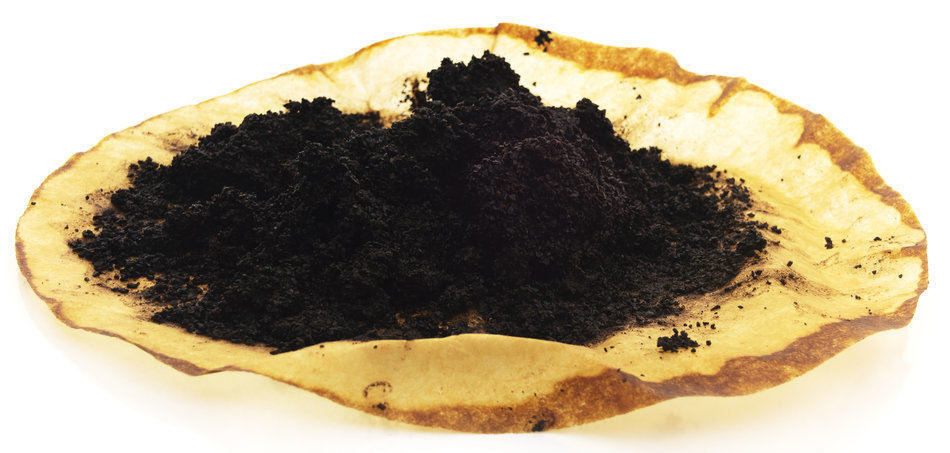
Check your sources
Like I said earlier, a quick Google search of coffee grounds for gardening will bring up a lot of hits. You will find many blogs, gardening articles, and random people in comments sections that will tout coffee grounds as a miracle substance for gardens.
I hate to be the one to burst your bubble.
However.
Remember to check your sources. Just like back in grade school, when you were navigating your first research projects, and your teacher was so picky about teaching you to find good sources. There’s a lot of information out there, and not all of it’s equally valid.
A good trick to zone in on the solid research around coffee grounds in the garden is to type “.edu” as part of your Google search. This will bring up articles and websites endorsed by universities and other academic institutions. This will help filter your search to writers who were academically accountable for what they said, and often proved what they said with scientific data and experiments (or referred to other credible sources’ date and experiments).
So, if you have to choose between “My Garden Butterfly Blog” and a brochure published by Oregon State University, choose the latter.
Even amongst credible sources, though, you’ll need to pay attention. A lot of research about using coffee waste for gardening/agricultural purposes relates to other coffee by-products, such as the pulp and peel, hulls or husks of the coffee plant, or the waste water produced from making coffee. Most of us don’t have access to that stuff, and the research there’s not necessarily applicable to the soggy grounds in our coffee machines.
Make sure you’re looking at information specific to using coffee grounds in the garden.
Caution needed: adding coffee grounds to soil
Dumping coffee grounds into the garden can have disastrous effects. If you want to add coffee grounds directly to your soil, you need to use caution.
Mulch
As mulch, coffee grounds have a very fine texture and can easily become compacted. For this reason, a thick layer of coffee grounds can block moisture and air movement, making it a poor choice for mulch.
Caffeine in coffee
The reason most kitchens have used coffee grounds to dispose of every morning (and the reason that some of us are very much addicted to coffee) is the fact that coffee helps wake us up. Coffee contains caffeine, and in the coffee plant the purpose of this caffeine is allelopathy – reducing the germination and growth of competing plants around them.
Remember that competition for resources is the engine behind a lot of plant and animal behaviour. As I write these words, I’m looking at a shelf full of seedlings set in front of my sunny window. Let me tell you, the way some of them reach out, block other smaller plants with broad leaves, snatching up as much sunlight as possible …. It’s naked aggression out there.
Some studies suggest that caffeine is part of this competition for resources because it can inhibit the development of root systems in young plants, effectively cutting them off from the nutrients they need. Dumping your coffee grounds into your soil, therefore, can actually trigger the exact opposite effect of what you’re going for – suppressing the growth and health of your plants.
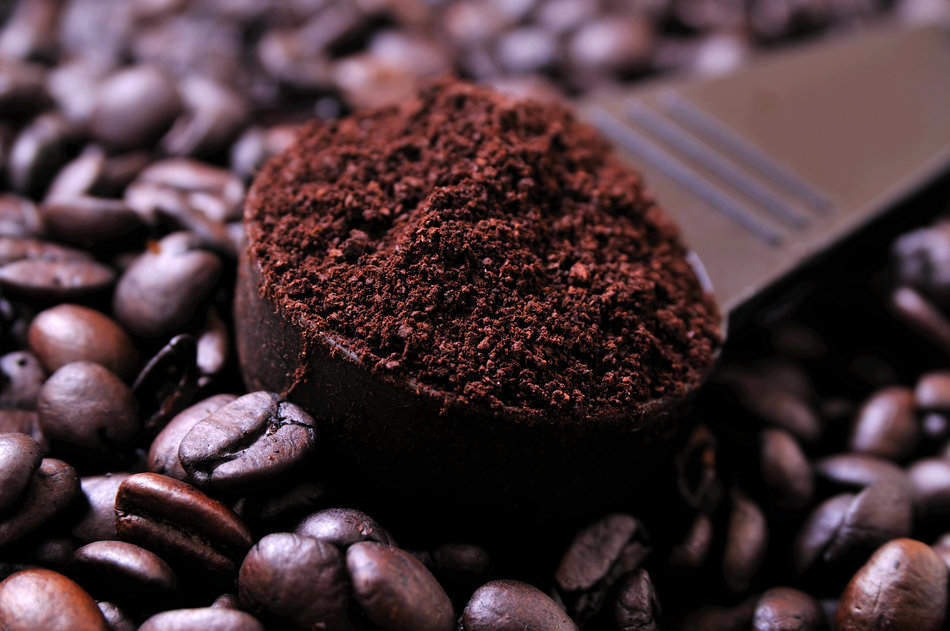
Nitrogen in coffee
One of the most common reasons that coffee is touted as an excellent addition to soil is the fact that it’s a great source of nitrogen. Like all living things, plants need nitrogen to survive and to thrive – specifically, nitrogen is a key component of chlorophyll. Chlorophyll is the green pigment in plants that captures sunlight and turns it into sugars. It’s chlorophyll that captures the sun’s limitless energy and, through plants, turns it into stuff that the rest of the food chain depends on.
Even though nitrogen makes up 78% of earth’s atmosphere, plants and other living things (like us) can’t access it in that form. It’s made accessible to plants when it’s broken down in the soil by organisms. Eventually, that nitrogen in the plant (or in the animal that eats the plant) is accessible to us through food.
Coffee grounds have nitrogen. Plants need it. Seems like a win-win.
Not exactly.
Coffee grounds encourage the growth of microorganisms to break them down. Those microorganisms actually use up a lot of the nitrogen that the plants need. So if you add coffee grounds to the soil, you actually have to add a nitrogen fertilizer along with them.
So – coffee grounds are a source of nitrogen, but not a nitrogen fertilizer.
Acidity of Coffee
Another commonly held assumption is that coffee grounds are acidic, and that’s why they make a great addition to soil.
Why would a gardener want to add an acidic substance to their garden? Most plants thrive in slightly acidic soil, and certain types of plants really prefer acidity. Azaleas, blueberries and rhododendrons are a few examples. When discussing soil acidity, remember: the lower the pH, the more acidic the soil. The higher the pH, the more alkaline the soil.
There are many reasons you might want to boost the acidity of your soil, but the best way to do that is not by adding coffee grounds. Even blogs and articles that suggest you take caution adding coffee grounds to the soil do this on the assumption that coffee grounds are acidic, arguing that you need to make sure they’re not too acidic for what you’re growing.
The reality is that coffee grounds are not acidic – or, at least, not predictably acidic.
Most of the acidity in coffee grounds is water soluble, so it ends up in your coffee cup, not in the leftover grounds. In various scientific experiments, coffee grounds have been unpredictable in their acidity, and in whether or not they lower the pH of soil or a compost pile. In some experiments, the coffee grounds were slightly acidic or neutral; in one experiment, researchers found that adding coffee to compost actually temporarily increased soil pH.
So if acidity is what you’re after, there are more reliable ways to achieve it. Peat moss, acidic fertilizer, and compost rich in organic materials (including coffee grounds!) are some other options to explore.
Coffee as a pest control?
Another reason people add coffee grounds directly to soil is based on claims that coffee grounds can be a useful pest control, particularly to discourage slugs and snails. The sources I found only mentioned this as a possibility; at this point, any evidence is largely anecdotal. Again, if pest control is your issue, there might be more proven methods of dealing with it.
Coffee as a weedkiller?
For the same reasons that some plants suffer around coffee grounds, some research suggests that coffee grounds can help manage weeds. If toxic substances are released by decomposing coffee grounds and damage other plants, this “negative effect” could have a positive result if the stunted plants were unwanted weeds. Some experts speculate that if coffee grounds were added to soil near established and woody plants, such as larger shrubs and trees, perhaps only germinating seeds and seedlings (of weeds!) would be stunted.
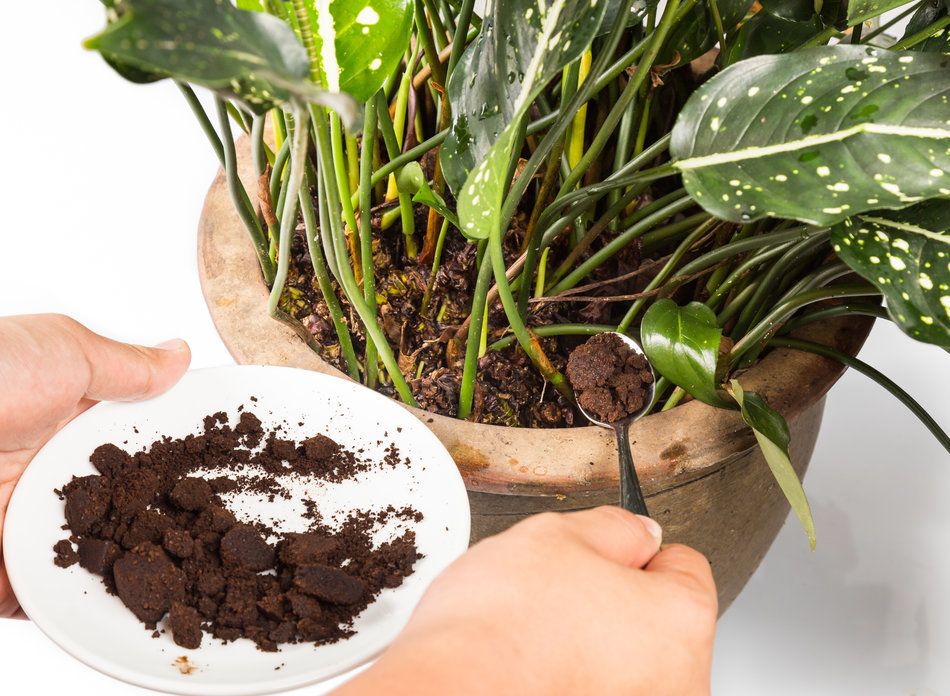
Tips for adding coffee directly to your soil
All in all, the research points to the fact that coffee grounds should be added directly to soil with caution and, ideally, not at all. Instead, coffee grounds should be composted before being served up to your plants.
If you do decide to add coffee grounds directly to your soil, here are a few tips:
- Check if the types of plants you’re growing happen to be the few plants that enjoy fresh coffee grounds. These include sugar beets, cabbage and soybeans.
- Remember, add a nitrogen fertilizer along with your coffee grounds. Coffee grounds are a source of nitrogen, but not a nitrogen fertilizer.
- Spread a thin layer of coffee grounds (no deeper than half an inch), then cover it with about four inches of a coarse organic mulch, such as leaves, wood chips, or bark mulch.
- Don’t let coffee grounds dry out. When dry, they actually repel water, not help retain it.
- Don’t put un-composted coffee grounds near young plants.
- Don’t blame me if you don’t get the best results.
Like their pH level, coffee grounds’ effect on plants can also be unpredictable, varying greatly from plant to plant. In some experiments, coffee ground composts have improved germination and yields in plants like sugar beets, cabbage and soybeans. Some plants, however, are negatively affected by coffee. Alfalfa, clover, Chinese mustard, and geraniums are a few examples of plants that were actually inhibited by being exposed to coffee grounds. Anecdotally, some gardeners have reported almost all their plants suffering from an overdose of coffee grounds to the soil.
Why coffee grounds are great for compost
While you should be cautious about adding coffee grounds directly to soil, coffee grounds are an excellent addition to compost.
Nitrogen
As mentioned above, coffee grounds are an excellent source of nitrogen. So excellent, in fact, that coffee grounds can actually replace nitrogen-rich manure in the compost pile. Coffee grounds have a carbon-to-nitrogen ration of 20 to 1, which puts it in the same range as animal manure.
Most of us don’t have livestock faeces being produced on a daily basis at home, but we definitely have regular amounts of coffee grounds to toss–or, at least, the coffee shop down the street does. Besides the fact that it’s around, coffee grounds are also a great replacement for animal manure because there’s no concern about pathogens.
Even the most zealous gardeners will admit that coffee grounds don’t have the ick factor that animal poop does. If you’re like me, and your gardens and compost piles are regularly touched by little hands (that don’t understand the concepts of proper hygiene quite yet and tend to eat things with those same messy fingers), the idea of coffee grounds replacing fresh manure has some obvious benefits.
Temperature sustainment
In one study, coffee grounds actually outdid manure in the temperature department. When coffee grounds made up 25% of the compost pile, higher temperatures were sustained longer than the comparative piles using manure. These high temperatures kill off pathogens, as well as the seeds of plants and weeds that are in the compost.
Coffee grounds’ ability to turn up the heat has uses beyond the compost pile. Hot beds are typically gardens that are heated by fermenting manure; some farmers have replaced coffee grounds in their hot beds, and have been impressed with the results. According to some of these growers, coffee grounds in hot beds can break down more easily and sustain the heat more effectively than livestock manure.
And, again, less ick factor. (And lower risk of my toddler eating animal poop.)
Coffee improving soil structure
Coffee grounds also tend to improve the structure and quality of composted soil. They seem to have a connection to higher numbers of earthworms and earthworms are a gardener’s best friend. They break down organic matter and aerate the soil, allowing it to retain water and air more effectively. Worm castings (another word for poop, without saying poop) are garden gold, making an excellent fertilizer.
The exact nature of the relationship between coffee grounds and earthworms is unclear. Some sources said that the coffee grounds attract earthworms, others said that the coffee grounds improve soil structure and that attracts earthworms, others said that the soil structure is improved by the earthworms pulling the coffee grounds into the soil.
Whatever the case, coffee grounds make for better soil structure.
Reduces growth of bacteria and mold
When added to compost, coffee grounds have also been proven to reduce the growth of certain fungi, molds and bacteria. In one test, cheeses covered with coffee grounds had less bacteria growth than cheese without coffee grounds. There’s been little real testing regarding the disease suppression of coffee grounds – it’s only been proven for a few types of vegetables.
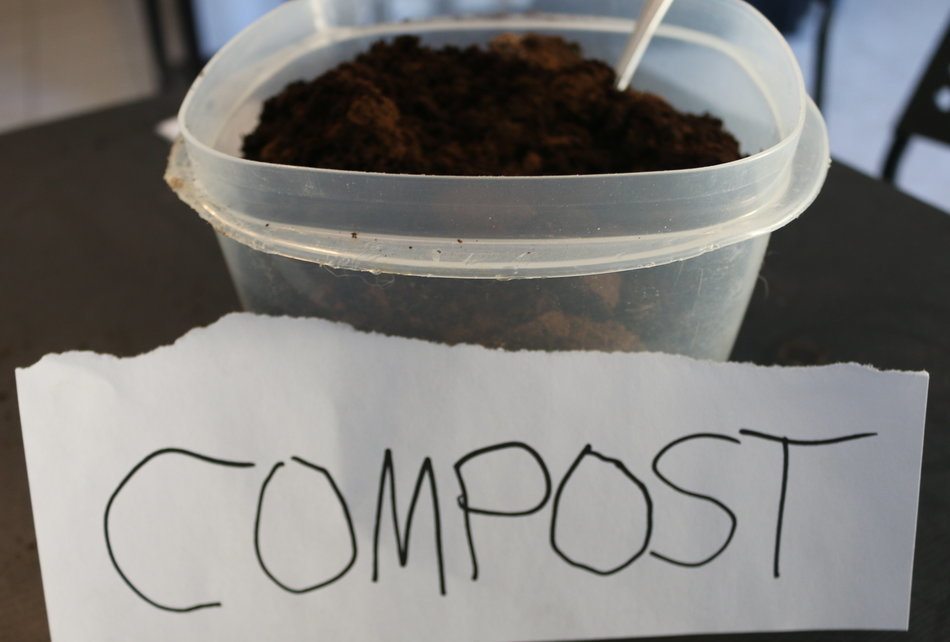
How to add coffee grounds to compost
Like many things in life, coffee grounds in compost can easily become too much of a good thing. Even though they’re being composted first, not thrown directly into the soil, you still need to watch your ratios to get the best results.
Green or brown?
When looking at compostable materials, gardeners refers to “greens” and “browns.” Green compostable materials include items that are high in nitrogen, such as grass clippings, food scraps, and manure. Brown compostable materials are things that are high in carbon and contain little nitrogen – examples include wood chips, branches, and dry, dead leaves.
The art and science of composting requires striking the right balance between these two categories.
So, what are coffee grounds? Green or brown?
Right. They are green. Well, they’re not green–they’re the color brown, but they are definitely in the “green” category of compostable materials. They’re an excellent source of nitrogen and can replace manure.
How much coffee should be in your compost?
When adding coffee grounds to compost, keep them between 10 and 20 percent (or less) of your compost pile. This range has demonstrated positive effects, but anything over 30 percent has had proven negative effects. When it comes to disease suppression, particularly, a little can go a long way. Composted soil in which coffee grounds were as little as 0.5 percent of the material showed reduced levels of fungi and bacteria.
Coffee grounds need to be balanced out in the compost pile by other materials. A lot of carbon matter, such as leaves and grass clippings, needs to be added.
A few simple ways to add coffee grounds to your compost pile:
- Use the ratio of 1/3 coffee grounds, 1/3 grass clippings, and 1/3 leaves to create a compost pile. Layer the ingredients and turn the pile once a week. In three to six months, you’ll have composted soil. This “recipe” was repeated by several reputable sources I came across in my research.
- If you’re adding coffee grounds to an existing compost pile, just be sure to add at least an equivalent amount of shredded paper or dried leaves. Tossing in the paper coffee filters, along with the coffee grounds, is one way to add to your amount of carbon materials (and take one more thing out of the landfill).
Collecting coffee grounds
Using coffee grounds in compost is an excellent way to not only show some love to your garden, but to the earth in general.
Every day, pounds and pounds of compostable coffee grounds and paper filters are sealed up in plastic garbage bags, eventually finding their way to landfills. Diverting coffee grounds out of the landfill and into the compost pile is a pretty manageable small step that most of us can take toward caring for the environment.
Collecting coffee grounds from local coffee shops expands this environmentally friendly impact, and also builds connections within the community. A great way to collect coffee grounds from a coffee shop or diner is to leave a bin labelled with your name and phone number, have the employees dump any coffee grounds into the bin, and stop by regularly to empty it.
You can store coffee grounds for future use, too. They don’t go bad. Just throw them into a large container or garbage pail, saving them for the next time you want to add them to the compost pile.
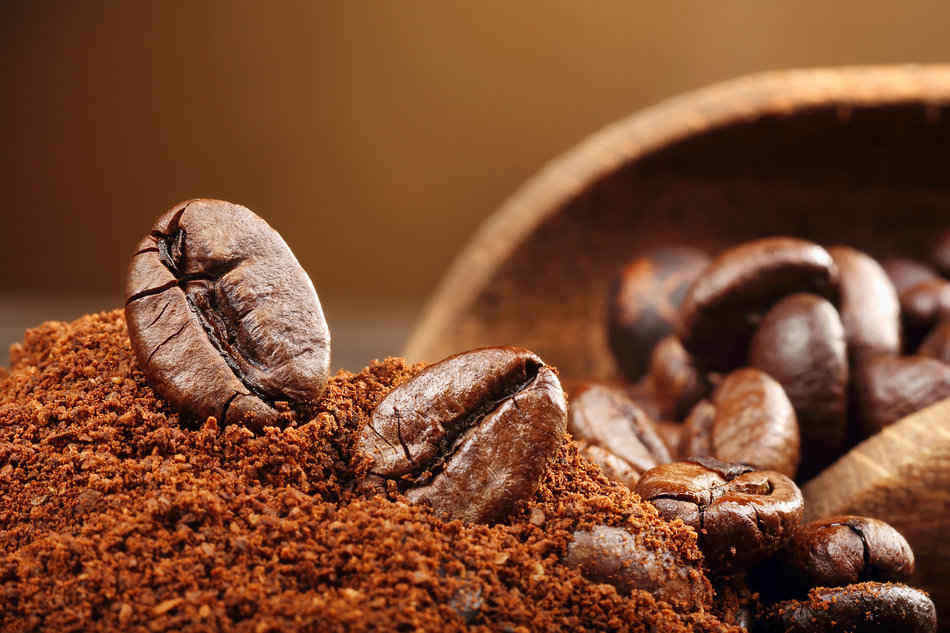
Related questions
Can you put too much coffee grounds in your garden?
Yes, you definitely can put too much coffee grounds in your garden. Added to the soil directly, particularly near young plants, coffee grounds can have detrimental effects. They can inhibit plant growth and seed germination. If you add coffee grounds directly to your soil, spread only a thin layer, stay away from young plants, and cover it in a layer of at least four inches of coarse organic mulch. A better way to use coffee grounds in the garden is to put coffee grounds in your compost pile first.
Which plants like used coffee grounds?
For most plants, the best way for them to access the nutrients in used coffee grounds is by composting the grounds first. However,a few plants that seem to benefit from coffee grounds as mulch are sugar beets (seed germination), cabbage, soybeans, and anthuriums.
Which plants don’t like coffee grounds?
For most plants, the best way for them to access the nutrients in used coffee grounds is by composting the grounds first. Seed germination has been stalled in plants such as alfalfa and clovers, and coffee grounds has inhibited the growth and yield crops such as: Chinese mustard, tomatoes, geranium, and asparagus fern.
So, the next time you’re about to toss those wet coffee grounds in the garbage bin, think again. They may look brown, but remember that they’re green. They’re an excellent source of nitrogen to add to the compost pile, they’re environmentally friendly, and in the end, they can help feed your growing, healthy garden.


